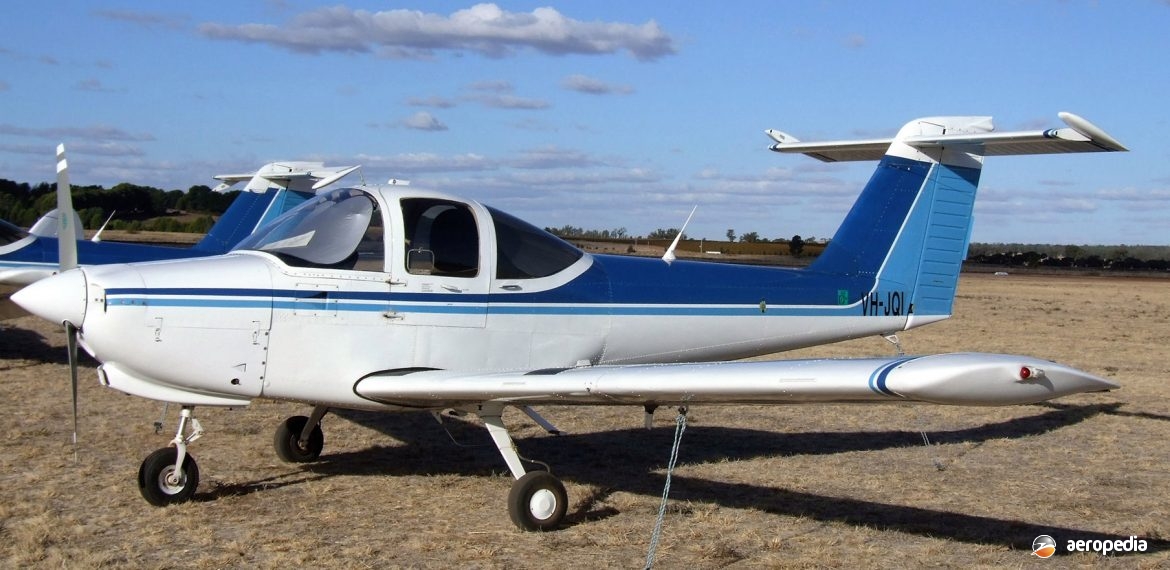Photograph:
Piper PA-38-112 Tomahawk VH-JQI (c/n 38-78A0572) at Narrandera, NSW in April 2006 (David C Eyre)
Country of origin:
United States of America
Description:
Two-seat training and touring monoplane
Power Plant:
One 84 kw (112 hp) Avco Lycoming O-235-L2C four-cylinder horizontally-opposed air-cooled engine
Specifications:
- Wingspan: 10.36 m (34 ft)
- Length: 7.04 m (23 ft 1¼ in)
- Height: 2.63 m (8 ft 7½ in)
- Wing area: 11.61 m² (124.97 sq ft)
- Max speed at sea level: 209 km/h (130 mph)
- Cruising speed at 75% power at 2,680 m (8,800 ft): 202 km/h (125 mph)
- Cruising speed at 65% power at 3,505 m (11,500 ft): 189 km/h (117 mph)
- Stalling speed flaps down: 85 km/h (52 mph)
- Initial rate of climb: 213 m/min (700 ft/min)
- Service ceiling: 3,917 m (12,850 ft)
- Range at 202 km/h (125 mph): 745 km (463 miles)
- Range at 189 km/h (117 mph): 807 km (500 miles)
- Fuel capacity: 121 litres (26.6 Imp gals)
- Empty weight: 483 kg (1,064 lb)
- Loaded weight: 757 kg (1,670 lb)
History:
The Tomahawk was designed by Piper Aircraft basically as a good, all-round, training aircraft with emphasis on simplicity of maintenance and low operating costs, and to compete with the Cessna 150 series on the world market. Many of the components could be interchanged on the aircraft and, like its main competitor, the similar-looking Beech 77 Skipper, the Tomahawk employed a T-tail which, it was claimed, afforded greater stability and more positive rudder control, and permitted precise spin training. The positive response gave better conditions for practising stalls. The wing was an adaptation of NASA’s Whitcomb aerofoil which provided optimum in-flight visibility, ground handling, safety, and landing ease.
The design had a constant thickness and rectangular planform wing with a high aspect ratio to reduce drag. Accommodation was provided for two side-by-side under a bubble canopy, and entry doors were provided on each side. Power plant chosen was the 84 kw (112 hp) Lycoming O-235-L2C four-cylinder unit and it had a fixed tricycle undercarriage. It was certified for limited aerobatics in the utility category.
The PA-38 Tomahawk trainer was announced in October 1977, and customer deliveries commenced early in 1978, with more than 1,000 having been delivered by the beginning of 1979 when production was exceeding 100 a month. A further 1,000 were delivered during the next 12 months or so but then slowed down and by the time production ceased in 1983 a total of 2,497 had been delivered.
First deliveries of the type in Australia occurred in mid-1979, the distributor being Ansett General Aviation. By late that year 27 were in service with flight schools and some 13 clubs and schools in Australia had specified the type for training purposes, these including Air Training Centre at Archerfield and Gold Coast Aero Club, QLD, Royal Aero Clubs of NSW and Victoria, NASA at Cessnock, NSW Albury Air Centre, NSW, Darwin Aero, NT, Cliff Brown Flight School, and the Albany Club in WA. For the following few years it proved very popular with aero clubs and training organisations throughout Australia and New Zealand, with more than 120 registered in this region.
The first change to the design occurred with the 1980 model, the pilot’s workload to lower the flaps being significantly lowered by the reduction of the aerodynamic load. Production of the Tomahawk was suspended in 1983, was resumed in 1985, but ceased again because of US product liability laws. In 1984 a new variant appeared, produced by Calypso Airways, an operator at Easton in Maryland, this Company converting Tomahawks to a conventional tail, Fowler type flaps, a new flap actuating mechanism, a shimmy damper for the nosewheel, new brakes, improved door hinges and latches, extra soundproofing and other modifications. The new aircraft became known as the Calypso Kiddy Hawk.

